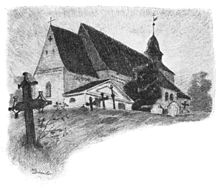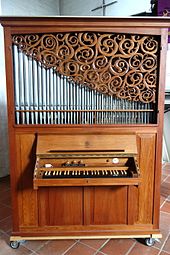St. George on the mountain
The church St. Georg auf dem Berge in Ratzeburg is the old bishop's church and mother church of the Lauenburger Land. The surrounding parish churches and also the Ratzeburg Cathedral were founded from here.
history
The origin of the church “St. George on the hill "is associated with the onset of proselytizing the resident polabians in the 10th century who had built on the island Ratzeburger a central sanctuary and a fortress. Your bishop was first mentioned in 992.
Two personalities played an important part in the further course of the early history of this church: the abbot Ansverus and the duke Henry the Lion .
Ansverus
Ansverus became known for his martyrdom, which he suffered as abbot at the monastery of the church in 1066 during the uprising of the Poles. This death led to his canonization and established a veneration of Ansverus, which even beyond the Reformation of the Evangelical Lutheran. Church in Lauenburg is maintained to the present day.
The bones and with them the relics of Ansverus found their resting place in the altar of the church. The grave slab intended for this with the inscription "OSTJUM SEPULCHRI" (entrance to the altar grave) is today on the south arched wall that separates the nave from the chancel; until 1971 it was directly at the altar.
Henry the Lion
In 1093 , the pagan Slavs were finally defeated by Heinrich von Alt-Lübeck in a spectacular battle near Schmilau , only 6 km from St. Georg . A period of consolidation and reconstruction followed, in which the church building was restored with field stones in the form of a Romanesque basilica . Field stones in the south wall of the nave are evidence of this basilica .
In 1154 Evermod, a Premonstratensian from Magdeburg, was installed in this church by Heinrich the Lion as bishop for the diocese of Ratzeburg.
With this investiture in “St. Georg auf dem Berge “, Henry the Lion, as a duke, performed an act that was reserved for an emperor or king and which he therefore had to fight hard for.
So this investiture created a bond between the duke and this church and its bishops, which lasted until his death.
Romanesque brick building
For this bishop's investment, however, the existing small basilica had to be expanded considerably. With financial support from the Duke, a choir with a Romanesque vault was added to the original church space in the east behind an arched wall; while in the west behind an arched wall a large vestibule, also provided with a Romanesque vault, was added. This vestibule served as a station for the great procession of the bishop and his entourage preceding the service.
In the time of Henry the Lion, a single-nave Romanesque building was created, divided into a vaulted vestibule, a flat-roofed nave and a vaulted choir.
This building was sheathed with brick. This is remarkable because it was a building material that had just been newly developed at the time and whose technology was not yet fully developed. For this reason, the stepped cornice in the north window of the western part and the execution of the various decorative shapes on the upper edge of the outer wall still seem rather clumsy.
It is one of the oldest brick churches. As evidence of their age, the shaped stones that form the edges of the windows and portals have the "scratches", corrugations that are characteristic of the first brick technology.
Realignment
With the completion of the cathedral on the island in the 13th century, “St. Georg auf dem Berge “its importance as a bishopric. In addition, the situation was consolidated, so that twelve parishes could be parished from their district by 1230 to improve the spiritual supply of the country and St. George itself became a normal parish church with an area of responsibility that essentially still applies today.
leprosy
The further history of the church is characterized by two peculiarities: With the outbreak of leprosy in the 13th century, a monastery hospital for people affected by leprosy was created in the vicinity of the church. As the St. Jürgen Hospital, it left its mark on the remains of the foundation wall and in a street name, Seekenkamp (Siechenkamp).
Church and castle
In addition, the close connection between the church and the castle, which existed from the earliest times, was preserved, which was located at the foot of the St. Georgsberg directly opposite on the island. In the beginning dependent on their protection, over time they had developed into the castle's spiritual companion. The pastor of St. George was also ducal court preacher and received part of his salary from the castle.
Due to this connection, the “royal and electoral ambassadors of Ratzeburg” could later be buried in the sandy subsoil of this church, as it was called: “in the sand”. And the district council of the Duchy of Lauenburg held its opening services in the church “St. Georg auf dem Berge ”.
Church fire and renovation

In 1561, exactly thirty years after the Reformation was introduced, the church was ravaged by a severe fire. The vault of the vestibule, the ceiling of the nave and almost the entire interior were destroyed. As early as 1566, under Duke Franz, the church was given a new roof and new chairs. Inside the church, the vestibule was completely rebuilt: the arched wall to the nave was removed, the hall was provided with a flat ceiling and the nave could be expanded considerably at the expense of the hall. The rest of the hall then made up the vestibule, and the nave was given its current shape. Remnants of the shield arches that once supported the vault of the old vestibule can still be seen on the organ gallery on the outer walls.
In 1569 the church received a small bell that is still rung today when children are baptized. Around 1680, a small tower in the form of a lantern was added to the church in the west, with beams extending down to the anteroom.
The big bell was donated for this tower in 1681, which by itself accompanies the dead on their last journey and, together with the two bells acquired in 1960, forms a festive three-way ring for services and weddings.
Furnishing
The altar table , which dates from the earliest times, was given a baroque attachment in 1720. It is somewhat reminiscent of the former Fredenhagen altar by Thomas Quellinus in the Marienkirche in Lübeck . A crucifixion group is framed by the allegories of faith and hope and crowned with angels . In the same baroque style, the ceiling above the nave was provided with a stucco ceiling, only over the part that belonged to the old nave (before the great fire).
The choir stalls date from around 1600, as does the small cupboard door next to the altar with the relief of the Annunciation; it was originally part of an old pulpit.
A special feature is the large granite baptism, which is considered the largest in northern Germany. Until 1973 it was located as a well stone on a meadow in the Ratzeburg suburb, the Dermin, and has been called "Smilower Döp" for centuries. This baptism probably dates from the 12th century.
The bronze door in the entrance portal was designed by Prof. Carl Schubert in 1954 and contains the passion story; every time the door handle is depressed, Judas has to bow to Christ. At the top, however, in the pointed arch, St. George, the conqueror of the dragon and of evil, greets those who enter.
organ
The organ was built in 1973 by the organ builder Klaus Becker (Kupfermühle). The purely mechanical instrument has 25 stops on two manuals and a pedal .
|
|
|
|||||||||||||||||||||||||||||||||||||||||||||||||||||||||||||||||||||||||||||||||||||||
- Coupling : II / I, I / P, II / P
In the church there is still a mobile positive organ with three registers from Becker from 1959, which is used as an accompanying instrument or as a figured bass instrument at orchestral concerts . Sometimes it is also played with the main organ in works for two organs. The disposition is:
|
||||||||||||
literature
- Walter Klingenberg, "St. George on the mountain, history of the oldest church in the Lauenburger Lande" in Lauenburgische Heimat issue 193, Ratzeburg 2013, pp. 8–51
- Adam von Bremen : Gesta Hammaburgensis ecclesiae pontificum digitized
- Hartwig Beseler (ed.): Art topography Schleswig-Holstein. Neumünster 1974
Web links
Individual evidence
- ↑ Annalistica Saxo z. 992 (MGSS 6, 636) cf. Lorenz Hein in Schleswig-Holsteinische Kirchengeschichte, Neumünster 1977, p. 120
- ↑ Adam Brem. hist. ecclesiast. III, 50
- ↑ see Lauenburg Church Order v. 1558
- ↑ Stefan Weinfurter p. 105 ff in: Investiture and Coronation Rituals, Marion Steinicke and Stefan Weinfurter (eds.), Cologne 2005
- ↑ Peter Ganz, Commentary on Heinrich des Löwen's Gospels, Frankfurt a. M. 1989, p. 36
- ^ Alfred Kamphausen, Die Baudenkmäler der deutschen Kolonisierung in Ostholstein, Neumünster 1938, p. 114
- ^ Richard Haupt, Architectural and Art Monuments in Schleswig-Holstein, Heide 1925, p. 53 ff
- ↑ see Data from the Society for Leprosy ( Memento of the original from December 10, 2014 in the Internet Archive ) Info: The archive link has been inserted automatically and has not yet been checked. Please check the original and archive link according to the instructions and then remove this notice. (PDF)
- ↑ Lauenburgische Heimat Heft 73 u. 81, Ratzeburg 1972 a. 1974
- ↑ Information about the organ on the St.Gorgsberg website ( memento from September 10, 2012 in the web archive archive.today )
Coordinates: 53 ° 41 '55.87 " N , 10 ° 45' 31.38" O






